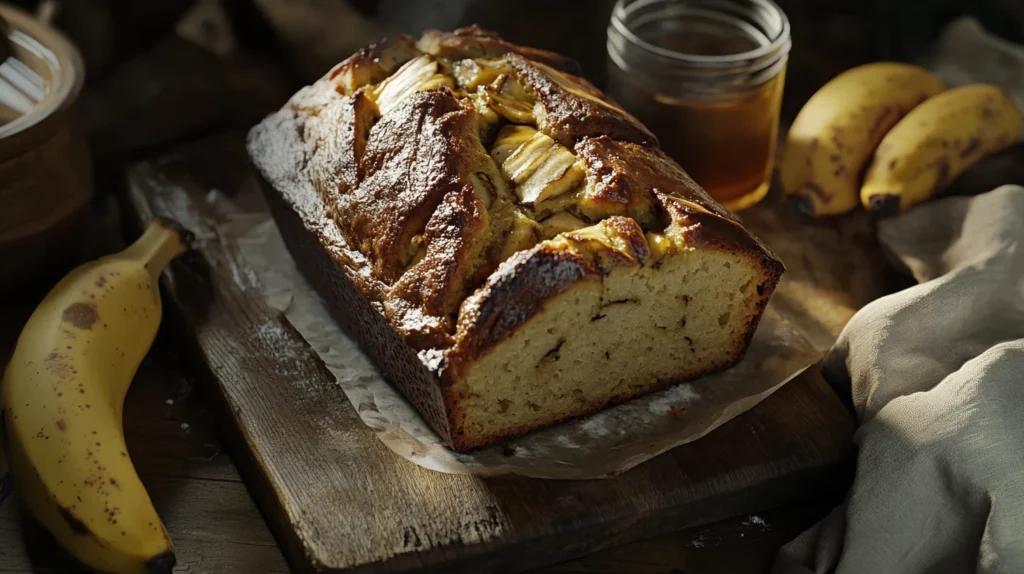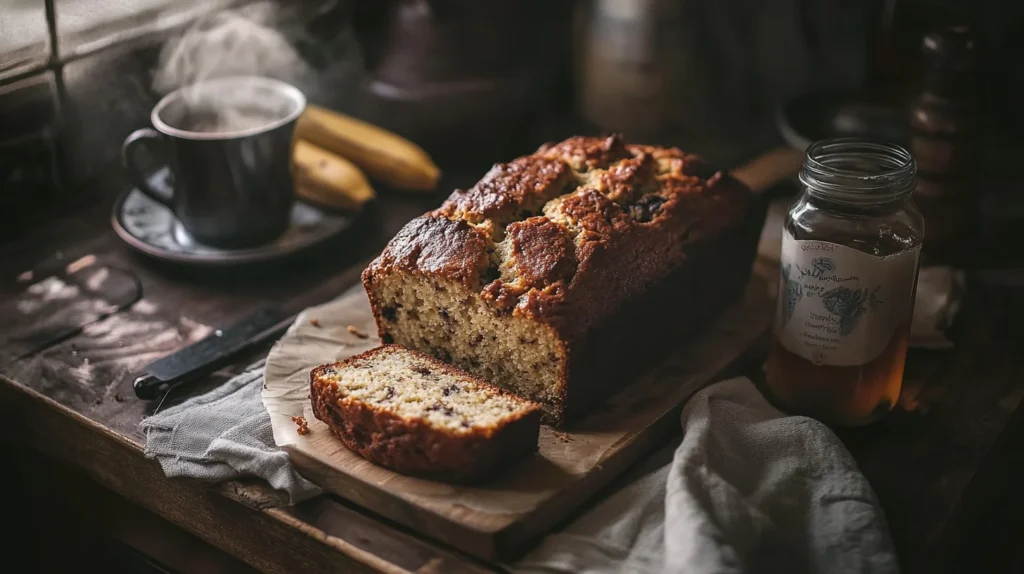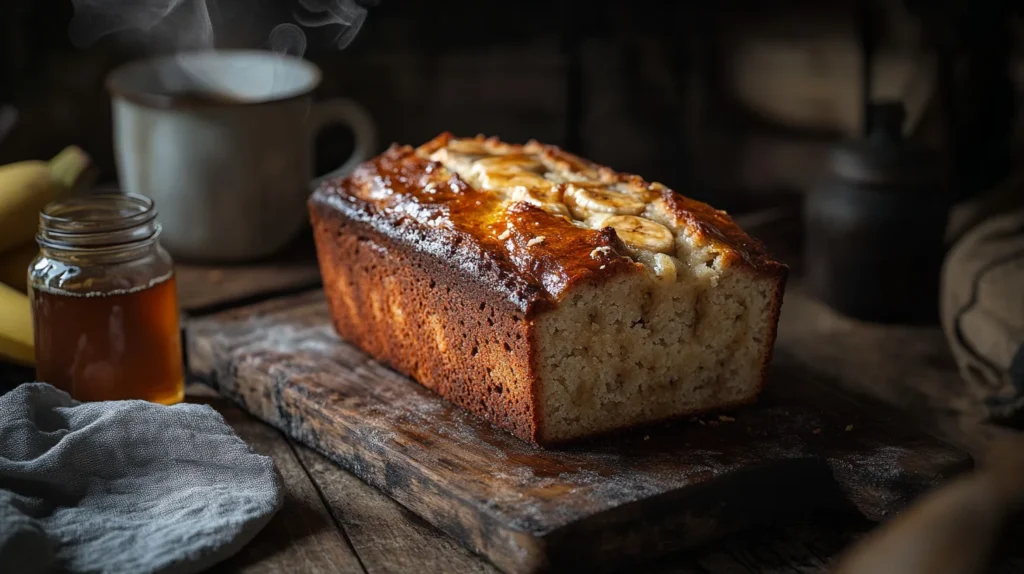Banana Bread Recipe No Butter:Moist &Delicious
In the realm of baking, few treats evoke nostalgia quite like banana bread. Its captivating aroma wafting from the oven can transport anyone back to warm memories of family gatherings and kitchen experiments. Today, we delve into a deliciously wholesome Banana Bread Recipe No Butter that will not only satisfy your cravings but also align with healthier eating habits. This recipe substitutes butter with alternative ingredients, preserving the moist texture and rich flavor you crave while offering a lighter twist on this beloved classic.
Introduction to Banana Bread Without Butter
The Appeal of Banana Bread
Banana bread holds a special place in the hearts—and stomachs—of many. Its simple preparation and delightful taste make it a go-to recipe for both novice and seasoned bakers alike. The beauty of banana bread lies in its versatility; whether served as breakfast, a snack, or a dessert, it can be enjoyed at any time of day.
Moreover, the inherent sweetness of ripe bananas makes it an excellent base for experimentation. You can easily customize your banana bread with various add-ins like nuts, chocolate chips, or spices, allowing each loaf to reflect your unique palate. The comforting familiarity of banana bread is a hug for the soul, making it a cherished treat in many households.
Health Benefits of Skipping Butter
One of the primary draws of our Banana Bread Recipe No Butter is the health benefits associated with reducing saturated fats. Traditional butter is high in calories and fat, which are not ideal for those watching their weight or striving for a healthier diet. By omitting butter, we open the door to alternative fats that contribute essential nutrients without compromising flavor.
Substituting butter with options like applesauce, yogurt, or nut butters adds moisture while lowering calorie intake. Additionally, these alternatives often come packed with vitamins, minerals, and antioxidants. For example, applesauce provides dietary fiber and vitamin C, promoting digestive health and boosting immune function. Enjoying banana bread made with these healthier swaps allows you to indulge guilt-free, making every bite truly satisfying.
Overview of Ingredients Needed
Before diving into the recipe, let’s take a closer look at the essential ingredients that will transform your overripe bananas into a luscious loaf of banana bread. Each component plays a vital role in achieving the perfect balance of flavor, texture, and nutrition. From the star ingredient—bananas—to the supporting cast of dry and wet ingredients, understanding their functions will empower you to create a masterpiece in your kitchen.

Essential Ingredients for the Recipe
Ripe Bananas: Choosing the Right Ones
The cornerstone of any great banana bread is undoubtedly the bananas themselves. Selecting the right bananas is crucial for maximizing flavor and moisture. Look for bananas with brown spots on the peel, indicating optimal ripeness. These darkened areas signal that the sugars have developed fully, giving the bread a naturally sweet taste without the need for excessive added sugar.
When you select your bananas, keep in mind that you don’t have to use solely yellow ones—overripe bananas that are nearly black are actually perfect for baking. They offer the sweetest flavor and contribute to the moistness of the final product. If you find yourself with bananas that are too ripe beyond immediate consumption, consider freezing them. Just peel and store them in airtight bags for future baking sessions.
Alternative Fats: Options for Moisture
As we explore substitutes for butter, you’ll discover numerous options to ensure your banana bread remains moist and flavorful. Here are some popular alternatives:
- Applesauce: This is a common replacement for butter that adds delightful moisture while cutting calories. It also lends a subtle apple flavor that complements bananas beautifully. Aim for unsweetened applesauce to maintain control over the sweetness of your banana bread.
- Greek Yogurt: Packed with protein and probiotics, Greek yogurt transforms your banana bread into a nutritious treat. Using plain yogurt brings a mild tanginess to the mix, enhancing the overall flavor profile.
- Nut Butters: Peanut or almond butter introduces healthy fats and a creamy texture to your banana bread. Just be cautious with the quantity, as nut butters can be calorically dense. Use them in moderation to achieve a harmonious blend of flavors.
With these alternatives, you can maintain the signature moistness of banana bread without the heaviness of butter. Each choice comes with its set of benefits, so feel free to experiment to find what suits your taste best.
Sweeteners: Natural vs. Refined
Banana bread’s natural sweetness often means we can reduce the amount of added sugar. However, sweeteners still play a vital role in balancing flavors and enhancing the overall experience. When choosing sweeteners for your Banana Bread Recipe No Butter, consider the following options:
- Honey or Maple Syrup: Both honey and maple syrup provide a rich sweetness while contributing unique flavors. They are liquid sweeteners, meaning you may need to adjust the ratios of your dry ingredients accordingly. They also come with their own health benefits, such as antioxidants and anti-inflammatory properties.
- Coconut Sugar: A less refined option than traditional white sugar, coconut sugar has a caramel-like flavor that pairs excellently with bananas. It also boasts a lower glycemic index, providing a slower release of sugar into the bloodstream.
- Stevia or Monk Fruit Sweetener: If you’re looking to minimize calories further, consider using stevia or monk fruit sweetener. These natural zero-calorie sweeteners can effectively replace sugar while still delivering the desired sweetness.
Experimenting with different sweeteners allows you to personalize your banana bread recipe according to your health goals and taste preferences. Be mindful of the intensity of sweetness each alternative provides, adjusting the quantities to achieve that perfect balance.
Dry Ingredients: Flour Types and Their Roles
The foundation of any baked good is its dry ingredients, and when it comes to banana bread, flour choices can significantly affect the final product’s texture and flavor. Here are some flour types to consider:
- All-Purpose Flour: The most commonly used flour for baking, all-purpose flour provides a neutral flavor and ideal structure for banana bread. If you prefer a light and fluffy texture, stick with this classic option.
- Whole Wheat Flour: Incorporating whole wheat flour increases the nutritional value by adding fiber and essential nutrients. While it might result in a denser loaf, the nutty flavor complements the sweetness of bananas nicely.
- Almond Flour or Coconut Flour: For gluten-free adaptations, almond or coconut flour serves as excellent alternatives. Almond flour brings a rich, buttery flavor, while coconut flour absorbs moisture more readily, requiring adjustments to the liquid ingredients.
Each type of flour contributes its unique characteristics, allowing you to craft banana bread that aligns with your dietary preferences. Don’t hesitate to experiment with combinations to discover your perfect blend.
Optional Add-Ins: Nuts, Chocolate Chips, and Spices
To elevate your banana bread experience, consider adding extra elements that enhance flavor and texture. Here are some popular add-ins to consider:
- Nuts: Walnuts and pecans are classic additions that deliver crunch and depth of flavor. Not only do they add texture, but they also introduce healthy fats and proteins. Toasting nuts before incorporating them into the batter can amplify their flavor even further.
- Chocolate Chips: If you’re a chocolate lover, chocolate chips can take your banana bread to the next level. Dark chocolate chips provide a rich contrast to the sweetness of the bananas, creating a decadent treat that satisfies cravings.
- Spices: Cinnamon, nutmeg, or vanilla extract can add complexity to your banana bread. A dash of cinnamon is especially complementary to banana flavors, evoking warmth and comfort. Don’t shy away from experimenting with other spices to find your favorite combination.
Including these optional add-ins allows you to tailor your banana bread to suit your mood, occasion, or personal taste. Feel free to mix and match to create a unique loaf that reflects your culinary creativity.

Step-by-Step Instructions
Preparing Your Ingredients
Once you’ve gathered your ingredients, preparing them properly sets the stage for success. Take a moment to measure out your dry and wet ingredients separately before beginning the mixing process. Having everything ready to go simplifies the overall baking experience and prevents any last-minute scrambling.
Make sure your bananas are appropriately ripened before mashing, as this ensures maximum sweetness and moisture content. Use a fork or potato masher to break the bananas down until they are smooth, leaving only small chunks if you prefer a bit of texture in your bread.
Additionally, preheat your oven to the specified temperature before starting the mixing process. This allows the oven to reach the desired heat, ensuring efficient baking once the batter is poured in.
Mixing Wet Ingredients
Begin by combining your wet ingredients in a large mixing bowl. Depending on your chosen fat substitute, mix together your mashed bananas, alternative fat (like applesauce or yogurt), and sweeteners until evenly blended. Whisking the ingredients thoroughly helps to aerate the mixture, leading to a lighter loaf.
If you’re using eggs, they should be added at this stage. Eggs act as a binding agent, helping to hold the loaf together while contributing moisture and richness. For vegan adaptations, opt for flaxseed or chia seed “eggs” as a suitable replacement.
Take care to mix the wet ingredients until they are well combined, but avoid overmixing. This step sets the foundation for your banana bread, so aim for a homogenous mixture without lumps.
Combining Dry Ingredients
In a separate bowl, whisk together the dry ingredients, including your chosen flour, baking soda, baking powder, and salt. This step is crucial to ensure even distribution of leavening agents throughout the batter, preventing any pockets of dense or undercooked areas in your bread.
For added flavor, consider incorporating spices or grated lemon zest at this juncture. The aromatic components can elevate the overall taste profile of the banana bread, making it a more delightful experience.
Gradually incorporate the dry mix into the wet ingredients, stirring gently until just combined. Avoid vigorous mixing, as this can lead to a tough loaf. The key to perfect banana bread is to mix until no visible dry flour remains while still retaining a slight lumpiness in the batter.
Folding in Bananas and Optional Add-Ins
Now comes the moment you’ve been waiting for: folding the mashed bananas and any optional add-ins into your batter! Gently add your mashed bananas to the batter, ensuring they are evenly distributed without overmixing.
If you opted for nuts, chocolate chips, or additional spices, fold them in carefully at this stage. Taking care not to overmix protects the delicate structure of your banana bread, resulting in a tender crumb.
Feel free to adjust the amounts of add-ins based on your personal preference. More chocolate chips? Go for it! Extra walnuts? Absolutely! This is where you can truly make the recipe your own, tailoring it to fit your tastes.
Baking the Banana Bread
Once your batter is perfectly mixed, pour it into a greased loaf pan. Smooth the surface with a spatula to ensure even baking. Place your banana bread in the preheated oven and bake until golden brown and a toothpick inserted into the center comes out clean.
Baking times can vary depending on the specific ingredients and size of your loaf pan, so keep a watchful eye. If the top begins to brown too quickly, covering it with aluminum foil can prevent burning while allowing the inside to cook through.
After baking, allow your banana bread to cool in the pan for about ten minutes before transferring it to a wire rack. This cooling period allows the bread to set correctly, making it easier to slice without crumbling.

Tips for Perfect Banana Bread
Achieving the Right Texture
The perfect banana bread strikes a balance between moistness and structure. To achieve this, begin with overripe bananas as previously discussed—they serve as the backbone of the bread’s moisture.
Be mindful of the mixing process. Overmixing can activate the gluten in the flour, resulting in a dense loaf rather than the light, fluffy texture you desire. Aim to mix until just combined, preserving the integrity of the batter.
Finally, conduct a toothpick test to determine doneness. If the toothpick comes out with moist crumbs but not wet batter, your banana bread is perfectly baked. Remember that the bread will continue to cook slightly after being removed from the oven due to residual heat.
Storage Solutions for Freshness
To maintain the freshness of your banana bread, proper storage is crucial. Once cooled completely, wrap the loaf tightly in plastic wrap or aluminum foil to preserve moisture and prevent it from drying out. Alternatively, you can store slices in an airtight container.
For longer-term storage, consider freezing your banana bread. Slice it into individual pieces, wrap each slice securely, and place them in a freezer-safe bag. This method allows you to enjoy banana bread for weeks to come—simply thaw slices as needed.
Troubleshooting Common Issues
Even seasoned bakers encounter challenges in the kitchen. Here are some common banana bread problems and how to address them:
- Banana Bread Too Dense: If your banana bread turns out dense, it may be a result of overmixing or using too much flour. Ensure that you’re measuring flour correctly and mixing just until combined.
- Bread Doesn’t Rise Properly: Insufficient leavening agents or expired ingredients can cause this issue. Always check the freshness of your baking soda and powder before use.
- Burned Top: If the top of your banana bread browns too quickly, cover it with foil halfway through baking to protect it from direct heat while allowing the inside to bake through.
With these tips, you can confidently tackle any hiccups during your baking journey, ensuring a successful outcome each time.
Variations on the Classic Recipe
Gluten-Free Options
If you’re following a gluten-free diet, banana bread can still be within reach. Use gluten-free flour blends specifically designed for baking, which typically combine various flours to mimic the texture of all-purpose flour.
Additionally, coconut flour can be utilized, though it absorbs more moisture than standard flours, necessitating adjustments in liquid ingredients to maintain the desired consistency.
Explore adding xanthan gum to replicate the elasticity of gluten, resulting in a satisfying texture reminiscent of traditional banana bread.
Vegan Adaptations
Transitioning to a vegan version of banana bread is simple with some strategic substitutions. As mentioned previously, replacing eggs with flaxseed or chia seed “eggs” works wonders. Combine one tablespoon of ground flaxseed or chia seeds with three tablespoons of water, allowing it to sit until gel-like in consistency.
Opt for plant-based alternatives for yogurt or milk, ensuring they don’t contain added sugars that could alter the flavor profile. Remaining mindful of sweeteners is equally important; keep it natural and steer clear of artificial ingredients.
Flavor Infusions: Adding Zest and Extracts
Elevate your banana bread to new heights by experimenting with flavor infusions. Citrus zests, such as lemon or orange, can brighten the overall taste without overpowering the banana flavor. A teaspoon of vanilla extract can also deepen the flavor profile, adding warmth and richness.
Additionally, consider incorporating spices like cardamom or ginger for an exotic twist. You might even explore savory options by adding herbs like rosemary or thyme for a unique take on banana bread. The possibilities are endless—let your creativity guide you!
Frequently Asked Questions
You can replace vegetable oil with applesauce, coconut oil, or melted butter, depending on your preference. Applesauce will add moisture and a hint of sweetness, while coconut oil offers a unique flavor and richness.
What is a substitute for butter in banana bread?
Vegetable oil, olive oil, yogurt, applesauce, or mashed bananas are excellent substitutes for butter in banana bread. These alternatives help maintain moisture and flavor, giving you a delicious result without the need for butter.
Can I use bananas instead of butter in baking?
Yes, mashed bananas can replace butter in most baking recipes. To substitute, use about 1/2 cup of mashed bananas for every 1 cup of butter. The bananas will provide moisture and sweetness to the recipe.
Why does my banana bread have no flavor?
If your banana bread lacks flavor, it could be due to using underripe bananas or insufficient seasoning. Make sure to use overripe bananas, which have a stronger flavor. Additionally, enhance the batter with vanilla extract, cinnamon, or nutmeg to add more depth to the taste.
What is a substitute for vegetable oil in banana bread?
You can replace vegetable oil with applesauce, coconut oil, or melted butter, depending on your preference. Applesauce will add moisture and a hint of sweetness, while coconut oil offers a unique flavor and richness.
Conclusion
Embracing a Banana Bread Recipe No Butter opens up a world of delicious possibilities while prioritizing your health. With each bite, you can relish the delightful marriage of flavors and textures that banana bread offers while enjoying the knowledge that you’ve made a wholesome choice.
From selecting the perfect ripe bananas to exploring endless variations and substitutions, the joy of baking banana bread is enhanced by the creativity and personalization it allows. Whether you enjoy it warm from the oven or as a make-ahead snack, this guilt-free indulgence promises to satisfy your cravings and nourish your body. So roll up your sleeves, gather your ingredients, and embark on the fulfilling journey of creating your own scrumptious banana bread!
Looking for the perfect party snack? Try Chips with Spinach Dip for a delicious and crowd-pleasing treat. Click here for the full recipe!
Print
Banana Bread Recipe No Butter:Moist &Delicious
- Total Time: 1 hour 10 minutes
- Yield: 1 loaf (12 slices) 1x
Description
This moist and delicious banana bread skips the butter but keeps all the flavor. Made with ripe bananas, oil, and a touch of cinnamon, this simple recipe is perfect for breakfast, snacks, or dessert. It’s easy to whip up with pantry staples and can even be customized with mix-ins like nuts or chocolate chips.
Ingredients
Dry Ingredients:
- 1 3/4 cups all-purpose flour
- 1 teaspoon baking soda
- 1/2 teaspoon baking powder
- 1/2 teaspoon salt
- 1 teaspoon ground cinnamon
Wet Ingredients:
- 2–3 ripe bananas, mashed (about 1 cup)
- 1/2 cup granulated sugar
- 1/4 cup brown sugar
- 1/3 cup vegetable oil (or melted coconut oil)
- 2 large eggs
- 1 teaspoon vanilla extract
Optional Mix-Ins:
- 1/2 cup chopped walnuts or pecans
- 1/2 cup chocolate chips
Instructions
-
Preheat and Prepare:
- Preheat the oven to 350°F (175°C). Grease and flour a 9×5-inch loaf pan or line it with parchment paper.
-
Mix the Dry Ingredients:
- In a large bowl, whisk together the flour, baking soda, baking powder, salt, and cinnamon.
-
Combine Wet Ingredients:
- In a separate bowl, mash the bananas until smooth. Stir in the granulated sugar, brown sugar, oil, eggs, and vanilla extract until well combined.
-
Combine Wet and Dry Ingredients:
- Gradually fold the wet ingredients into the dry ingredients using a spatula, mixing until just combined. Avoid overmixing to keep the bread tender.
-
Add Mix-Ins:
- If desired, gently fold in the nuts or chocolate chips.
-
Bake:
- Pour the batter into the prepared loaf pan. Bake for 50-60 minutes or until a toothpick inserted into the center comes out clean.
-
Cool:
- Let the banana bread cool in the pan for 10 minutes, then transfer it to a wire rack to cool completely before slicing.
Notes
- Oil Substitution: Use applesauce or Greek yogurt as a healthier alternative to oil.
- Banana Ripeness: The riper the bananas, the sweeter and more flavorful your bread will be.
- Storage: Store at room temperature for 2-3 days in an airtight container or freeze for up to 3 months.
- Variations: Add 1 teaspoon of nutmeg or a handful of dried fruit for additional flavor.
- Prep Time: 10 minutes
- Cook Time: 50-60 minutes
- Category: Breakfast/Dessert
- Method: Baking
- Cuisine: American
Nutrition
- Serving Size: 1 slice
- Calories: 180
- Sugar: 12g
- Sodium: 150mg
- Fat: 6g
- Saturated Fat: 1g
- Unsaturated Fat: 5g
- Trans Fat: 0g
- Carbohydrates: 30g
- Fiber: 1g
- Protein: 3g
- Cholesterol: 25mg
Keywords: Banana Bread No Butter, Butter-Free Banana Bread, Healthy Banana Bread, Easy Banana Bread, Moist Banana Bread

